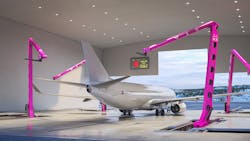MSG Aviation To Build the 'World’s Largest Robot' at Oslo Airport
Green technology and artificial intelligence developed in Norway will land at Avinor Oslo Airport (OSL) when what is being called the world’s largest robot from MSG Aviation is ready for use next year. The robot can potentially replace the current manual and time-consuming processes for deicing of aircraft, as well as washing, engine washing and technical inspection. For the airlines, this means reduced costs and lower carbon emissions.
After several years of testing and development, followed by a preliminary project with government-owned airport operator Avinor, the Norwegian company MSG Aviation will start building the world’s largest robot.
The robot will remove snow and ice from single-aisle and twin-aisle aircraft, clean the fuselage and engines, as well as conduct technical inspections of the planes. This is possible through MSG Aviation’s proprietary artificial intelligence software.
In the preliminary project, it was crucial to map out how the use of the robot should be adapted to the operation and traffic flow at OSL, not least during peak hours when many airplanes need to be deiced.
“We are very pleased to announce that we can now start the building of the world’s largest, and first robot exclusively constructed for deicing, washing, engine washing and technical inspection of aircraft at OSL. Together with OSL, we have found the best solution that ensures safe and efficient operations,” said CEO and major shareholder of MSG Aviation Ove Trøen.
“There is no reason why airlines should continue with manual, time-consuming and expensive processes, when we can do it faster, better, more environmentally friendly, and more cost-effective by using new technology. We can contribute to the airlines improving their efficiency and on-time performance, while saving money on fuel and reducing emissions,” said Trøen.
Exciting Project
MSG Aviation is lending the area at the airport from Avinor for a period of three years.
“For Avinor and Oslo Airport, it is crucial to explore new technology and constantly develop in line with innovation. In our industry, it’s all about safe and stable operation of our airports, and ensuring more efficient winter operations is of course crucial,” said Director of Technology and Infrastructure at Oslo Airport Ole Petter Storstad.
He underscored that the pilot project that will now be launched is an opportunity that Avinor wanted to facilitate.
“For us, it was a given to collaborate with the Norwegian company MSG Aviation, which invests heavily in innovative technology and challenges the established routines in parts of the aviation industry’s operations. It is exciting, and we look forward to collaborating on this project going forward,” he added.
Innovation Norway Supports Green Technology
Innovation Norway has supported MSG Aviation with financial funds and believes that this type of entrepreneurship is crucial.
“Change and innovation are crucial as we move towards a carbon-free future. The development of new, green technology is important to reach the goals of the Paris Agreement. MSG Aviation develops smart and green solutions for aviation that will help reduce emissions, not only in Norway, but internationally. Innovation Norway believes in and supports entrepreneurial businesses such as MSG Aviation. That is why we have contributed funds to develop the world’s largest robot, which will now be built at Oslo Airport,” said regional director Anniken Fægri Damm-Larsen at Innovation Norway.
Clean Aircraft Reduce Emissions
According to the MSG Aviation news release, regular exterior washing of aircraft results in less air resistance, consequently reducing fuel burn of approximately 2 percent. By regularly cleaning the aircraft, the fuselage is less subject to wear and tear, which in turn results in lower maintenance costs.
“In other words, airlines all over the world have a need for these services, but with somewhat different needs. Here in the north, there is an obvious need for deicing and regular washing, while in other parts of the world, where planes fly over the desert, there is an obvious need for regular removal of sand from the fuselage and the engines,” said Trøen.
MSG Aviation has signed a letter of intent with the airlines Widerøe and Norwegian regarding washing, deicing and technical inspection of aircraft. Widerøe Ground Handling has signed an agreement to be the operator of the robot at OSL. The ground handler Menzies has also signed a letter of intent with the company.
“Widerøe Ground Handling offers ground handling services at 42 airports in Norway, including de-ice. As a company, we are always looking to modernize all our services, so that we can work smarter and more efficiently. MSG Aviation’s new robot gives us the opportunity to automate our processes, so that we not only reduce costs, but also significantly reduce carbon emissions,” said Chief Commercial Officer of Widerøe Ground Handling Kjell Ivar Maudal.
MSG Aviation’s robot is built to wash everything from larger passenger planes to smaller private planes. Military aircraft will also be able to use the robot.
